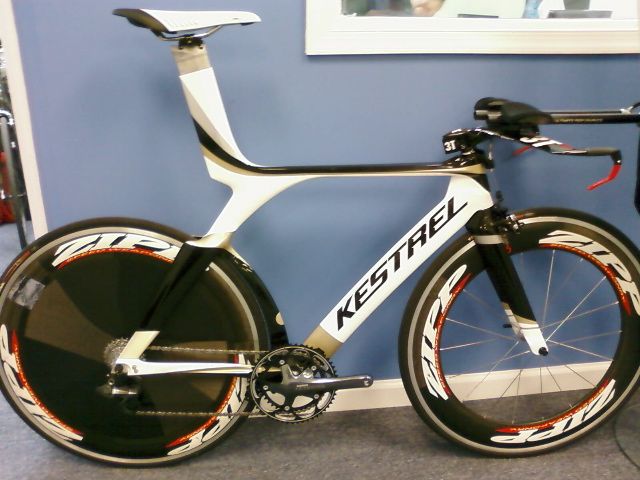First Clear Spy Shot of New Kestrel TT Bike
Here it is – the first side shot I’ve seen of the new Kestrel “Super Bike” TT frame.

We have no way of knowing how close this is to the finished product, but rumors have it this is nearly a done deal to be debuted in Kona. Rumors also have it this bike is mopping up the wind tunnel with its competitors, posting low drag numbers heretofore unseen (and Kestrel plans to publish the results of these tests). Apparently Kestrel is testing this bike vs competitors in “out of the box” setups to give a fair idea of the drag numbers a consumer can expect to achieve. They are also testing a wide variety of components to determine which work best with this frame. Another goal was to make the bike easy to work on.
Observations (based on the photo only – Kestrel isn’t talking):
- Center pull cantilever front brake. Eliminates the need for aerodynamically dirty cable housing. Similar to Specialized Transition.
- Broad fork blades incorporating mounting posts for cantilever brakes. There appears to be some slotting or interesting sculpting of the fork blades, and the fork crown fares into the downtube.
- No cables. It may be that this prototype simply doesn’t have the cables routed yet. Or, they could be concealed in the steerer/headtube and exit above the front tire, entering the down tube inside the crown faring. Also, there is no front derailleur (now that would be a trick! – I’m sure it’s just not mounted yet) and an electronic rear Dura-Ace derailleur.
- Concealed rear brake
- Very clean and low seat cluster area. The seat stays join the seat tube very low, similar to the Airfoil. This, along with the relocated rear brake, presents a very clean and thin trailing edge allowing air flow to pass between the rider’s legs easily, and likely helps it to rejoin flow passing over and around the rider, reducing low pressure (and hence drag) behind the rider.
- Seat stays form wings around the rear tire near the seat cluster area.
- Tiny, almost rudimentary seat tube. It fares the rear wheel, yes, but I wonder if it is mainly there to satisfy the UCI “double diamond” requirement. The Airfoil seems to do just fine with no seat tube or rear wheel faring.
- There also appears to be some unusual sculpting or slotting on the seat stays.
- The frame look to incorporate a variation on the integrated seat mast – an extended “seat tube mast” with internal post. My guess is the “seat tube mast” may still need to be trimmed to size, but the internal post should allow more adjustment than the caps used with seat masts. It is unclear how the seat post is fastened, and the post itself looks like it may be just a mock-up (quick prototype). In any case this may provide all of the advantages of an integrated seat mast (lighter weight, stiffer, cleaner interface) with greater adjustability. Or, they may add an extended cap onn the outside similar to the D6
- The seat mast looks to be built at 75 degrees, although there is some parallax distortion in the photo. This will suit UCI regulations well, but will mean that the final seatpost will need a movable clamp (perhaps like the Fuji D6) to get a steep seat angle.
We’ll post more info when we get it!

August 17, 2009 @ 9:44 pm
what a nice bike! i have been trying to get more info on it an nobody seems to know anything. im glad you posted this review. I hope you continue to provide more details and pics.